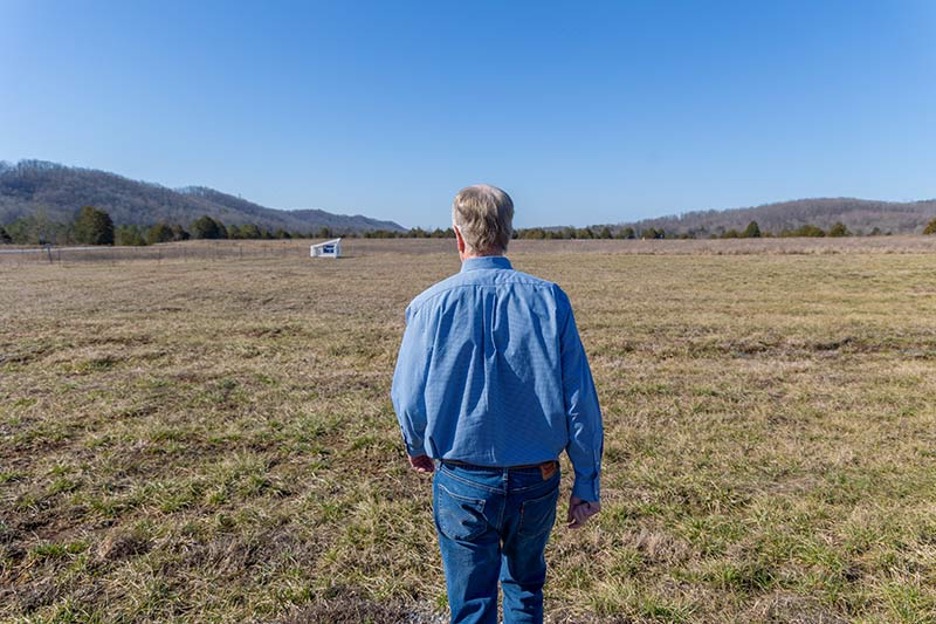Apr 17, 2025
Clinch River Project at Forefront of Nuclear Development
When Bob Deacy looks out over a grassy field at TVA’s Clinch River Nuclear Site, he sees America’s energy future – up to four state-of-the-art small modular reactors, each on a plot smaller than a football field.
He envisions an efficient workforce that relies on the latest digital equipment for all facets of operation.
And a facility that generates reliable power around the clock, contributing electricity to TVA’s portfolio of generating assets, from hydro, coal, gas and existing nuclear to solar and battery storage.
The reactors themselves will be a standard design, which will allow utilities around the world to benefit from these advancements in nuclear power.
The 935-acre Clinch River Nuclear Site in Oak Ridge and Roane County, Tennessee, is at the forefront of nuclear development, with the nation’s first early site permit for SMRs.
And Deacy, senior vice president of TVA’s Clinch River Project, is the person leading that program.
What would people see now if they visited the Clinch River site?
If you go to the interior of the site, you’d see a flat site that’s been cleared, and you’d see a lot of stakes with ribbons on them. You’d see four stakes – I call them corner fences – that outline the footprint for our proposed nuclear units. You will see in this relatively small space the potential for something significant for our nation’s energy future – affordable and reliable nuclear power.

TVA built this five-lane bridge to accommodate the heaviest load anticipated during SMR construction
What work has TVA already performed at the site?
To access the site, we had an old one-lane wooden bridge that came across a small river channel, part of the Clinch River. The first thing we did was replace that with a five-lane bridge that can handle the heaviest load – and the heaviest load would probably be the reactor vessel. We worked with Oak Ridge Utilities to bring in on-site construction power.
What are the next steps?
TVA has submitted a Notification of Intent to the Nuclear Regulatory Commission that we plan to submit our construction permit application by June 2025. That is a procedural way of saying we gave the NRC, the nuclear regulator, a formal heads-up that TVA plans to move to the next step in the NRC’s licensing process very soon.
The construction permit application is essentially the roadmap for the plant’s design and safety systems, and we have to have the NRC’s approval on the plans. This is a big deal because TVA will be the first to file a construction permit application for the BWRX-300, a design General Electric is developing in collaboration with TVA and an international consortium of utilities. TVA continues to evaluate the BWRX-300, as well as other SMR technology, as the standard design continues to mature.
Already, TVA has been in preliminary conversations with the NRC over our construction permit application to ensure it is ready for the NRC to begin its review. We are ready to rapidly engage with the NRC to help support deployment of the reactor across the United States.

Bob Deacy, senior vice president of the Clinch River Project, visits the site in Oak Ridge and Roane County, Tennessee.
Could you say more about the funding?
TVA’s Board of Directors has authorized up to $350 million for our construction permit application, activities related to potential, future deployment of an advanced reactor at the Clinch River Nuclear Site – including completion of the standard design of a small modular reactor – and engineering support and activities to study potential, future deployment of advanced reactors of various designs at various sites. We are applying for an $800 million Department of Energy grant with a number of other entities. Congress appropriated this funding last year to support the deployment of an SMR.
If we receive the DOE funding, we’d be able to roll into site-specific engineering. It may also allow us to procure some long lead items and do grading of the site itself. We’re working with DOE to help offset the cost so we don’t burden our customers with first-of-a-kind costs, because this is a first-of-a-kind plant, even though it’s based on proven technology. It stands to benefit the energy security of the entire country.
We are also evaluating alternative approaches to funding that could include investors, and we’re examining various structures and approaches. Again, these approaches are being considered to ensure that TVA’s customers don’t bear the burden of unique first-of-a-kind nuclear technology costs.
How did you get involved with the Clinch River Project?
When I was offered this role, I knew leadership wanted me to be as efficient and productive as possible in the planning and development, without putting a nuclear price tag on it.
My background includes a combination of nuclear power and construction, as well as planning and scheduling. Over my career, I’ve touched all aspects of the energy business – nuclear power, natural gas plants, coal plants, oil and gas exploration, dam repair, heavy construction and now the design of a small modular reactor.

Deacy speaks with, from left, senior project manager Mike McDowell and civil construction manager Buck Collins outside the construction trailer at the Clinch River Nuclear Site.
What are a few highlights of the project so far?
Most recently we were honored to have U.S. Energy Secretary Chris Wright and Sen. Bill Hagerty make their first visit to the site. Congressman Chuck Fleischmann was there as well – he has made many visits to the site and is a great partner. We had a meaningful discussion on significant topics to advance American-led energy in east Tennessee. Having Tennessee Gov. Bill Lee come to the site was probably one of the most memorable moments early in the project – seeing his views and his excitement for the Clinch River Project. I’ll never forget that day. The support from federal and local officials has been valuable to move this project forward.
When we had our first all-hands meeting about this project, we brought everybody in and got their thoughts. The room was full of excitement for the future of nuclear. It was a great day to see the expressions on people’s faces – they were engaged and excited.
What excites you personally about SMRs?
It reminds me of when I graduated from college and I got my first job in nuclear. It was in the early ’80s. At the time, there were maybe 10 to 12 nuclear plants under construction or in the startup phase – brand new plants, boiling water reactors, pressurized water reactors. There was just so much excitement and so many jobs to be had. Now I look at all the excitement for SMRs and it reminds me of back then. It’s almost like I’m reliving the past when nuclear was in its heyday. So we have a new heyday, but with a lot of new technology compared to the fleet we have out there today.
How are SMRs different than nuclear technology from just a few decades ago?
The SMRs we’re looking at right now are Generation III Plus technology, a similar technology to today’s larger reactors but with some advantages. SMRs offer enhanced safety and security features. With each unit being a smaller size, they operate in a smaller footprint, providing more siting options and a reduced construction timeline. We’re working with our collaborators on a standard unit design and, as the first units are built, we expect to see cost and construction timelines go down as the supply chain gets stronger. The similarities – such as using the same fuel as our Browns Ferry Nuclear Plant – are an advantage, too, in that there are fewer first-of-a-kind features, resulting in less overall risk.
Why is TVA interested in building SMRs now?
TVA’s mission is to benefit the people of the Valley region. We need to make sure we’re able to deliver – through our partners, our local power companies – uninterrupted, reliable, resilient power. That’s the mission, loud and clear. With all these data centers and AI centers, the growth we’re seeing in our sector is incredible. We need to continue to develop new projects that not only deliver power to all our existing customers, but also accommodate new customers. We have to power all the economic development projects that are coming into this region.
Are you a person who thrives on having a lot of responsibility on your shoulders?
I’ve always loved being involved in large projects from the early stages, but I think what’s most important is developing an organization and developing the staff – having the right people in the right places to be successful. That’s key. I’ve been with TVA for 18 years. I’ve been involved with more than $10 billion worth of projects, and those projects all came in on schedule and within budget. And it was because of the teams that did the work. Strong, talented teams are at the heart of TVA’s continued success.

